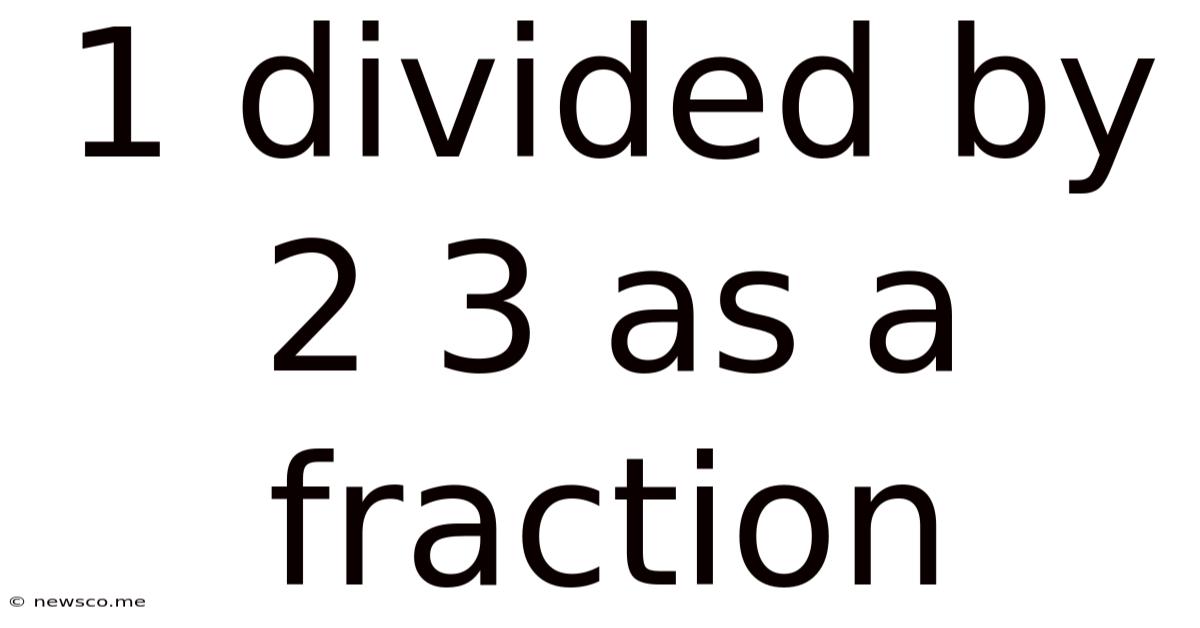1 Divided By 2 3 As A Fraction
News Co
May 03, 2025 · 4 min read

Table of Contents
1 Divided by 2/3: A Comprehensive Exploration of Fraction Division
Understanding fraction division can seem daunting at first, but with a clear explanation and some practice, it becomes straightforward. This article delves into the seemingly simple problem of 1 divided by 2/3, exploring the underlying principles, providing multiple solution methods, and expanding on the broader context of fraction division. We'll unravel the mystery behind this calculation and illuminate the path towards mastering fraction manipulation.
Understanding the Fundamentals: Fractions and Division
Before tackling the specific problem, let's refresh our understanding of fractions and division. A fraction represents a part of a whole. It consists of a numerator (the top number) and a denominator (the bottom number). The denominator indicates how many equal parts the whole is divided into, and the numerator indicates how many of those parts are being considered.
Division, in its simplest form, is the process of splitting a quantity into equal parts. When dividing by a fraction, we're essentially asking: "How many times does this fraction fit into the whole (or another fraction)?"
Method 1: The "Keep, Change, Flip" Method (Reciprocal Method)
This is arguably the most popular and efficient method for dividing fractions. It's based on the concept of reciprocals. The reciprocal of a fraction is obtained by swapping its numerator and denominator. For example, the reciprocal of 2/3 is 3/2.
The "Keep, Change, Flip" method involves these steps:
- Keep the first number (in this case, 1) as it is.
- Change the division sign (÷) to a multiplication sign (×).
- Flip (find the reciprocal of) the second fraction (2/3 becomes 3/2).
Applying this to our problem:
1 ÷ 2/3 becomes 1 × 3/2
Now, we simply multiply the numerators and the denominators:
(1 × 3) / (1 × 2) = 3/2
Therefore, 1 divided by 2/3 is 3/2, which can also be expressed as 1 ½ or 1.5.
Method 2: Visual Representation using Fraction Bars
A visual approach can reinforce the understanding of fraction division. Imagine a single bar representing the number 1. We want to see how many times a fraction bar representing 2/3 fits into this bar.
If we divide the whole bar into thirds, we can clearly see that one and a half 2/3 bars fit into the whole bar. This visually confirms that 1 ÷ 2/3 = 3/2 or 1 ½.
Method 3: Converting to a Complex Fraction
Another approach is to represent the division problem as a complex fraction. A complex fraction is a fraction where either the numerator, the denominator, or both contain fractions. Our problem can be written as:
1 / (2/3)
To simplify this complex fraction, we multiply both the numerator and the denominator by the reciprocal of the denominator:
(1 × 3/2) / ((2/3) × 3/2) = (3/2) / 1 = 3/2
This method highlights the equivalence between dividing by a fraction and multiplying by its reciprocal.
Expanding the Concept: Dividing Fractions in General
The methods described above can be applied to any fraction division problem. For instance, let's consider a more complex example:
5/6 ÷ 2/9
Using the "Keep, Change, Flip" method:
5/6 × 9/2 = (5 × 9) / (6 × 2) = 45/12
This fraction can be simplified by dividing both the numerator and the denominator by their greatest common divisor (GCD), which is 3:
45/12 = 15/4 or 3 ¾
Practical Applications of Fraction Division
Understanding fraction division is crucial in various real-world scenarios. Some examples include:
- Baking: Dividing ingredients according to recipes which may require fractional amounts. For instance, if a recipe calls for 2/3 cup of flour and you want to make half the recipe, you would need to calculate 1/2 ÷ 2/3 cup of flour.
- Sewing: Calculating fabric lengths based on patterns and fractions of yards or meters.
- Construction: Measuring and cutting materials precisely, which may often involve fractions of inches or centimeters.
- Finance: Calculating portions of investments or shares.
Troubleshooting Common Mistakes
While fraction division may seem simple, several common errors can occur:
- Incorrectly applying the "Keep, Change, Flip" method: Remember that only the second fraction is flipped. The first fraction remains unchanged.
- Forgetting to simplify the resulting fraction: Always simplify the fraction to its lowest terms by finding the GCD of the numerator and denominator.
- Incorrectly multiplying or dividing numerators and denominators: Double-check your calculations to avoid errors.
Conclusion: Mastering Fraction Division
Mastering fraction division is a foundational skill in mathematics with wide-ranging practical applications. By understanding the underlying principles and practicing different methods, you can confidently tackle any fraction division problem. Remember the "Keep, Change, Flip" method as a reliable and efficient approach, and don't hesitate to use visual aids or complex fractions to reinforce your understanding. Consistent practice is key to building fluency and accuracy in performing these calculations. Through understanding and application, the seemingly complex world of fraction division becomes manageable and even enjoyable. The seemingly simple problem of 1 divided by 2/3 serves as a perfect entry point into a more profound understanding of fraction manipulation and its relevance in everyday life. So, embrace the challenge, practice consistently, and watch your understanding flourish!
Latest Posts
Related Post
Thank you for visiting our website which covers about 1 Divided By 2 3 As A Fraction . We hope the information provided has been useful to you. Feel free to contact us if you have any questions or need further assistance. See you next time and don't miss to bookmark.